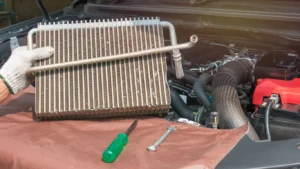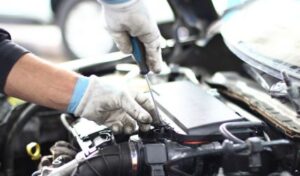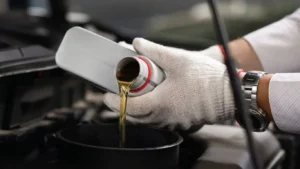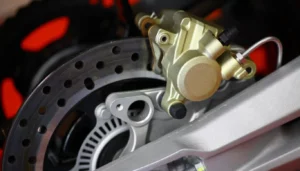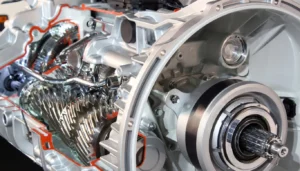A vehicle’s complex systems work together to provide smooth, reliable transportation. This network’s cooling system maintains engine temperature. If this system fails, it can cause engine overheating and damage.
Every car owner must understand car overheating causes and solutions. It helps detect problems and take immediate action. It can also prevent costly repairs and ensure road safety.
Components of the Car Cooling System
Understand the cooling system’s components and how they work to figure out why your car is overheating.
1. Radiator
The radiator is the cooling system’s core. It radiates heat to lower coolant temperature. Hot coolant enters the radiator’s top and cools through the channels. It should be cool enough to return to the engine to absorb more heat by the bottom.
2. Water Pump
The water pump circulates engine and radiator coolant. It keeps coolant flowing to maintain the engine’s optimal temperature, powered by the engine.
3. Thermostat
The thermostat controls coolant flow based on engine temperature. The engine warms quickly because the thermostat is closed when cold. The thermostat opens to circulate coolant and prevent engine overheating at the optimal operating temperature.
Role of Coolant in Maintaining Optimal Temperature
1. Types of Coolant
Your car’s cooling system needs coolant, or antifreeze. Inorganic Additive Technology (IAT), Organic Acid Technology (OAT), and Hybrid Organic Acid Technology are the main coolants (HOAT). Your car’s manufacturer will recommend one based on its durability and protection.
2. Importance of Coolant Levels
Coolant levels are crucial to your car’s cooling system. The radiator dissipates engine heat from the coolant. It prevents cooling system corrosion and raises water’s boiling point, allowing it to carry more heat.
If the coolant level drops too low, the engine’s heat won’t be managed. This can cause engine overheating and damage. Thus, checking and maintaining your vehicle’s coolant level is essential to avoid overheating.
What To Do If My Car is Overheating?
To prevent engine and other component damage from overheating, act immediately. If your car overheats, do these:
Driving an overheated vehicle can damage the engine and other parts. Address the issue immediately and get professional help if needed.
1. Pull over and turn off the engine
These steps will help you safely shut off the engine due to overheating:
a) Use your hazard lights:
To alert other drivers, activate your hazard lights.
b) Find a safe spot to pull over:
Pull over at a wide shoulder, parking lot, or designated pull-off area. Stopping on a curve or hill can endanger you and other drivers.
c) Slow down gradually:
Slow down and use your turn signal to alert other drivers. Avoid sudden moves that can cause accidents.
d) Get off the road:
Stay off the road. Check vehicle stability before stopping.
e) Apply the parking brake:
After stopping safely, apply the parking brake to secure your car.
f) Turn off the engine:
Turn off the engine and remove the key or press the stop button for keyless ignitions.
g) Stay in your vehicle or exit safely:
Staying in your car may be safer, especially on a busy highway or in a dangerous area. Carefully exit the vehicle away from traffic.
h) Call for assistance:
Call a tow truck or roadside assistance if needed. Before doing anything, let your car’s engine cool down.
Always prioritise road safety.
2. Allow the engine to cool
An overheating vehicle’s engine must cool down. Tips for engine cooling:
a) Turn off the engine:
Turn off the engine and remove the key or press the stop button for keyless ignitions. This reduces engine heat and speeds cooling.
b) Open the hood:
After cooling, open the hood. Opening the hood may release hot steam.
c) Wait for the engine to cool down:
Cool the engine first. This could take 15–30 minutes or longer depending on overheating and ambient temperature.
d) Do not touch hot engine components:
Avoid touching engine components while waiting for them to cool down.
e) Keep a safe distance:
To avoid injury from hot steam or coolant, stay away from the engine while waiting outside.
d) Monitor the temperature gauge:
Check your vehicle’s temperature gauge to see when the engine temperature is safe. If the gauge doesn’t normalise after a while, call for help.
e) Be patient:
Before addressing the overheating issue or making repairs, the engine must cool completely. Rushing can cause engine damage or injury.
After the engine cools, check the coolant level, leaks, and overheating cause. If the problem persists, call a tow truck or a mechanic.
3. Pop the hood
Pop the hood to access the engine or cool your car and pop the hood safely:
a) Locate the hood release lever:
The hood release lever is usually inside the vehicle’s cabin. This lever is typically under the dashboard or near the driver’s door. Consult your vehicle’s manual if you can’t find it.
b) Pull the hood release lever:
Release the latch by gently pulling the hood release lever. Partially unlocking the hood should click.
c) Exit the vehicle:
After releasing the hood latch, exit the vehicle, making sure it’s parked and the engine is off.
d) Locate the secondary hood release latch:
Feel for the secondary hood release latch under the front edge of your hood. If you can’t find this latch, check your vehicle’s owner’s manual.
e) Release the secondary latch:
Press or lift the secondary hood release latch. Lift the hood gently with your other hand.
f) Secure the hood in the open position:
Find a support rod or hydraulic arms to keep the hood open after unlocking and lifting it. Lift and insert the support rod if your vehicle has one. Hydraulic arms should hold your hood.
Opening the hood helps cool an overheating engine. It also lets you inspect the engine and other parts. Opening the hood can burn you from hot steam or engine parts.
4. Check the coolant level
Checking the coolant level is essential for diagnosing overheating or performing routine maintenance. Checking your car’s coolant safely:
a) Wait for the engine to cool:
Check coolant level after engine cooling. Opening the radiator cap or coolant reservoir while the engine is hot can release hot coolant and steam, causing burns or injuries.
b) Open the hood:
Use the support rod or hydraulic arms to secure the hood open.
c) Locate the coolant reservoir:
The translucent plastic coolant reservoir is near the radiator. It usually shows minimum and maximum coolant levels. Check your vehicle’s manual for the coolant reservoir’s location.
d) Check the coolant level:
Check reservoir coolant levels. The reservoir’s coolant level should be between minimum and maximum. If coolant is low, add more.
e) Check the radiator’s coolant level (if necessary):
If the coolant reservoir is empty or very low, check the radiator coolant level. After cooling, do this. Push down and rotate the radiator cap anticlockwise to remove it. Coolant should show near the radiator filler neck. If it’s low or invisible, add coolant.
f) Add coolant if needed:
To raise the coolant level, add 50/50 coolant and distilled water or pre-mixed coolant. Use the owner’s manual’s recommended coolant and a funnel to avoid spills.
g) Replace the radiator cap and close the hood:
Push down and clockwise to secure the radiator cap after opening it. Lower and lock the hood.
If you notice low coolant levels or leaks, have your car inspected. Coolant leaks can cause engine overheating and damage.
5. Inspect for leaks
To diagnose overheating or maintain your vehicle, check for coolant leaks. Here’s how to check for leaks:
a) Park the vehicle on a level surface:
Park on a flat, level surface and turn off the engine for an accurate inspection.
b) Allow the engine to cool:
Before checking for leaks, let the engine cool down. Hot coolant can burn or injure.
c) Open the hood:
Secure your car’s hood open.
d) Perform a visual inspection:
Check cooling system hoses, connections, and other parts for leaks. Check for wet spots, dried coolant residue and cracked hoses. Radiators, water pumps, heater hoses, and radiators leak.
e) Check beneath the vehicle:
Puddles or wet spots under your vehicle may indicate a coolant leak. Coolant leaks are green, yellow, or pink and smell sweet.
After the engine cools, carefully remove the radiator cap and inspect it for cracks or leaks. Damaged radiator caps can cause cooling system pressure imbalances and leaks.
f) Perform a pressure test (optional):
A cooling system pressure tester can pressurise the system and locate a leak. Auto parts stores rent this tool, or a mechanic can test it.
g) Monitor coolant levels:
If you can’t find a leak, monitor the reservoir’s coolant level. A slow leak may cause the level to drop.
Repair any coolant leaks immediately. Coolant leaks can cause engine overheating and other damage. See a mechanic for diagnosis and repair.
6. Check the radiator fan
When diagnosing an overheating issue, check the radiator fan because a faulty fan can reduce heat dissipation and raise engine temperatures. Check the radiator fan:
a) Allow the engine to cool:
To avoid burns, check the radiator fan after the engine has cooled.
b) Open the hood:
Secure your car’s hood open.
c) Locate the radiator fan:
Between the radiator and engine is the radiator fan. It may be a belt-driven mechanical fan or a vehicle-powered electric fan. If you can’t find it, check your owner’s manual.
d) Visually inspect the fan:
Look for broken blades, loose connections, or frayed wiring on the radiator fan. Check the mechanical fan clutch and belt for wear.
e) Check the fan’s operation:
Idle the engine until it’s warm. Watch the radiator fan from afar. To dissipate heat, the fan should turn on at a certain engine temperature. The fan motor, relay, temperature sensor, or electrical system may be the cause of a non-working fan.
f) Test the electric fan (if applicable):
If your car’s electric fan doesn’t work, try connecting it to the battery with jumper cables. If the fan runs directly from the battery, the fan relay, temperature sensor, or wiring may be defective and if the fan doesn’t work, replace the motor. When testing the fan motor, keep your hands and loose clothing away from the blades.
Consult a mechanic if you can’t check the radiator fan or find a problem. A broken radiator fan can cause engine overheating and damage.
7. Restart the engine
To safely restart your car’s engine after overheating or other issues, follow these steps:
a) Make sure the vehicle is in a safe location:
Park your car in a safe, level, traffic-free spot.
b) Ensure the engine has cooled down:
Wait until the engine cools before restarting. This prevents engine and component damage.
Before restarting, check and fill the coolant reservoir. Low coolant causes overheating.
c) Get inside the vehicle:
Take the wheel and buckle up.
Insert the key or activate the keyless ignition system: Put the key in the ignition or, if your car has a keyless ignition system, put the key fob in the car and press the brake pedal.
d) Start the engine:
Start the engine by turning the key to “start” or pressing the ignition. After starting the engine, release the key.
e) Monitor the dashboard:
To prevent engine overheating, watch the dashboard, especially the temperature gauge. If the engine temperature rises rapidly or reaches the red zone, turn it off and call for help.
f) Allow the engine to idle:
Before driving, idle the engine for a few minutes to reach its optimal operating temperature and check the cooling system.
g) Drive cautiously:
Drive cautiously and monitor engine temperature. Travel if the temperature is normal. If the engine overheats again, pull over and call for help.
Avoid engine and other component damage by addressing overheating issues immediately. Consult a mechanic for help diagnosing or fixing the issue.
8. Seek professional help
Professional assistance is recommended if you cannot diagnose or fix the overheating issue. A skilled mechanic can diagnose and fix the issue. Do this:
a) Find a reputable auto repair shop:
Ask friends, family, or coworkers for a local auto repair shop with good reviews. Choose a shop that knows your car’s make and model.
b) Call the repair shop:
Ask the repair shop if they can diagnose and fix the issue. To diagnose the problem, they may ask about your car’s symptoms.
c) Arrange for a tow or transportation:
Tow your car to the repair shop if it’s overheating or otherwise unsafe. Towing is often covered by auto insurance and roadside assistance.
d) Get an estimate:
After inspecting your vehicle, the mechanic will give you a repair estimate. Examine the estimate and ask questions about the recommended services.
e) Authorize the repairs:
If you approve of the estimate and repairs, let the mechanic start.
f) Stay in touch with the repair shop:
Communicate with the repair shop to track repairs and resolve any issues.
Pick up your car: The mechanic will call you when your car is ready. Before leaving the shop, test drive the vehicle and make sure the overheating issue is fixed.
To avoid engine and component damage, address overheating issues immediately. Checking coolant levels and cooling system components regularly can prevent overheating.
8 Reasons Why Your Car is Overheating?
Cooling system and component issues can cause overheating. Common car overheating causes include:
1. Low Coolant Levels: Low coolant levels cause engine overheating most often. Low coolant levels prevent engine cooling. Leaks, improper antifreeze/water mixtures, and lack of cooling system maintenance can lower levels.
2. Radiator Issues: Clogged or damaged radiators can cause overheating. Debris or sediment may block the radiator, preventing heat dissipation.
3. Faulty Water Pump: The water pump cools the engine. Overheating may occur if the water pump fails. Leaks, belts, and impellers can cause pump failure.
4. Stuck Thermostat: The thermostat regulates radiator coolant. It can overheat the engine if it gets stuck closed.
5. Blocked Coolant Hoses: Coolant hoses connect cooling system components. Blockages or damage can prevent coolant flow, causing overheating.
6. Inadequate Oil Levels: Engine oil reduces friction and removes heat. Low or dirty oil can raise engine temperature.
7. Faulty Radiator Fan: Air from the radiator fan cools the coolant. During slow driving or idling, a malfunctioning fan may not cool the engine.
8. Failed Head Gasket: The head gasket keeps engine coolant out. It can leak coolant into the cylinders, causing overheating and engine damage.
This list isn’t exhaustive, and your car may overheat for other reasons. If such issues arise, consult a professional mechanic.
Conclusion
Overheating can damage your engine and other parts if not addressed immediately. Overheating requires stopping, turning off the engine, and letting it cool. After the engine cools, check the coolant level, leaks, and radiator fan.
A qualified mechanic should be consulted if you can’t diagnose or fix the overheating issue. Regular cooling system maintenance and inspections prevent overheating and extend vehicle life.
Hot components and steam can burn or injure when handling an overheated engine.

